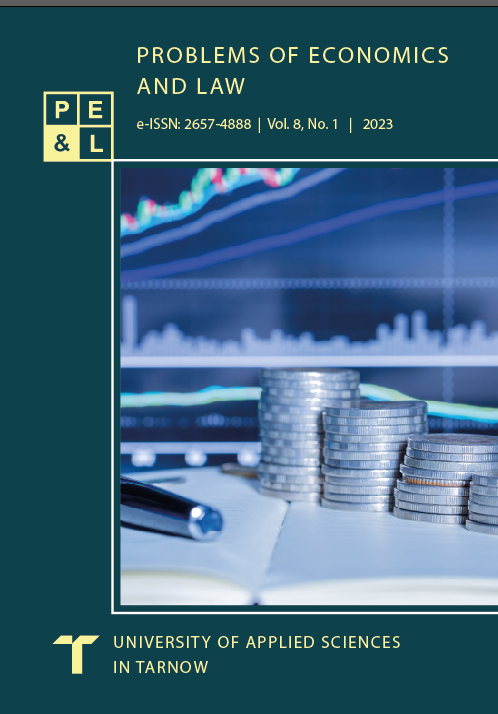The use of derivatives to reduce the volatility of companies financial results
DOI:
https://doi.org/10.55225/pel.490Keywords:
derivatives, hedging, International Financial Reporting Standards (IFRS), financial resultsAbstract
Purpose of the article: The aim of the study is to determine whether the use of derivatives by companies listed on the Warsaw Stock Exchange contributes to reducing the volatility of their financial results.
Materials and methods: For the purpose of verifying the hypotheses put forward in the work, the following research methods were used: critical analysis of domestic and foreign literature on the subject, analysis of quarterly financial statements of 241 companies from the non-financial sector listed on the Warsaw Stock Exchange, prepared for the years 2016–2019. The empirical material was subjected to statistical analysis using such methods as: tests of averages and multiple regression analysis
Results: The author’s own research, using statistical methods, showed that the use of derivatives by enterprises to hedge against financial risk contributes to reducing the volatility of the financial result (statistical significance).
Conclusions: Enterprises should use derivatives to hedge against the risk of changes in the prices of raw materials, commodities, exchange rates or interest rates. The use of hedging has a positive impact on the reported financial results. The use of derivatives also contributes to better cash flow management, which is particularly important during periods of significant turbulence on global markets.
Downloads
References
Alam, A., Afza, T. (2017). Impact of derivative usage on firm’s risk and value: A comparative analysis of Pakistan and Malaysia. Argumenta Oeconomica, 1(38), 221–242. DOI: 10.15611/aoe.2017.1.08. DOI: https://doi.org/10.15611/aoe.2017.1.08 Google Scholar
Alkebäck, P., Hagelin, N., Pramborg, B. (2006). Derivative usage by non-financial firms in Sweden 1996 and 2003: What has changed? Managerial Finance, 32(2), 101–114. DOI: 10.1108/0307435061064189. DOI: https://doi.org/10.1108/0307435061064189 Google Scholar
Barton, J. (2001). Does the use of financial derivatives affect earnings management decisions? The Accounting Review, 76(1), 1–26. DOI: 10.2139/ssrn.206869. DOI: https://doi.org/10.2308/accr.2001.76.1.1 Google Scholar
Bartram, S.M., Brown, G.W., Conrad, J. (2011). The effects of derivatives on firm risk and value. Journal of Financial and Quantitative Analysis, 46(4), 967–999. DOI: 10.1017/S0011209011000275. DOI: https://doi.org/10.1017/S0022109011000275 Google Scholar
Bednarski, R., Baryś, A. (2007). Wpływ zarzadzania ryzykiem finansowym na wartość firmy: analiza teoretycznych przesłanek wpływu zarządzania ryzykiem na wartość firmy. Acta Universitatis Lodziensis: Folia Oeconomica, 209, 25–35. Google Scholar
Beneda, N. (2013). The impact of hedging with derivative instruments on reported earnings volatility. Applied Financial Economics, 23(2), 165–179. DOI: 10.1080/09603107.2012.709599. DOI: https://doi.org/10.1080/09603107.2012.709599 Google Scholar
Berkman, H., Bradbury, M., Magan, S. (1997). An international comparison of derivatives use. Financial Management, 26(4), 69–73. DOI: 10.2307/3666128. DOI: https://doi.org/10.2307/3666128 Google Scholar
Campbell, J.L., Cao, S., Chang, H.S., Chiorean, R. (2023). The implications of firms’ derivatives use on the frequency and usefulness of management earnings forecasts. Contemporary Accounting Research. DOI: 10.1111/1911-3846.12883. DOI: https://doi.org/10.1111/1911-3846.12883 Google Scholar
Czekaj, J., Dresler, Z. (2002). Zarządzanie finansami przedsiębiorstw: podstawy teorii. Warszawa: Wydawnictwo Naukowe PWN. Google Scholar
Damodaran, A. (2017). Finanse korporacyjne: teoria i praktyka. Gliwice: Wydawnictwo Helion. Google Scholar
Doman, M., Doman, R. (2009). Modelowanie zmienności i ryzyka: metody ekonometrii finansowej. Warszawa: Oficyna a Wolters Kluwer business. Google Scholar
Firlej, K.A. (2011). Źródła i przebieg kryzysu finansowego w Stanach Zjednoczonych i Europie Zachodniej. Roczniki Ekonomiczne Kujawsko-Pomorskiej Szkoły Wyższej w Bydgoszczy, 4, 179–191. Google Scholar
Firlej, K.A. (2016). Programowanie rozwoju innowacyjności jako instrument podnoszenia konkurencyjności regionów w Polsce na tle Unii Europejskiej. Kraków: Fundacja Uniwersytetu Ekonomicznego w Krakowie. Google Scholar
Glaum, M., Klöcker, A. (2011). Hedge accounting and its influence on financial hedging: when the tail wags the dog. Accounting and Business Research, 41(5), 459–489, DOI: 10.1080/00014788.2011.573746. DOI: https://doi.org/10.1080/00014788.2011.573746 Google Scholar
Greenspan, A. (2008). The Age of Turbulence: Adventures in a New World. London: Penguin Books. Google Scholar
Hagelin, N., Holmén, M., Knopf, J., Pramborg, B. (2007). Managerial stock options and the hedging premium. European Financial Management, 13(4), 721–741. DOI: 10.1111/j.1468-036X.2007.00380.x DOI: https://doi.org/10.1111/j.1468-036X.2007.00380.x Google Scholar
Jajuga, K. (2019). Koncepcja ryzyka i proces zarządzania ryzykiem – wprowadzenie. In: Jajuga K. (red.). Zarządzanie ryzykiem. Warszawa: Wydawnictwo Naukowe PWN. Google Scholar
Jajuga, K. (red.). (2007). Zarządzanie ryzykiem. Warszawa: Wydawnictwo Naukowe PWN. Google Scholar
Jorion, P. (2007). Financial Risk Manager: Handbook. New Jersey: John Wiley & Sons. Google Scholar
Nisson, S. (1996). Świece i inne japońskie techniki analizowania wykresów. Warszawa: Wig-Press. Google Scholar
Nowak, E. (2017). Ryzyko kosztów i koszty ryzyka. Finanse, Rynki Finansowe, Ubezpieczenia, 4(88), 511–518. DOI: 10.18276/frfu.2017.88/1-49. DOI: https://doi.org/10.18276/frfu.2017.88/1-49 Google Scholar
Özek, P. (2016). An empirical investigation on the use of derivative instruments by industrial firms in Turkey. Finansal Araştırmalar ve Çalışmalar Dergisi, 14(8), 173–187. DOI: 10.14784/jfrs.23358. DOI: https://doi.org/10.14784/jfrs.23358 Google Scholar
Paligorova, T., Staskow, R. (2014). The use of financial derivatives by Canadian firms. Bank of Canada Review, Autumn, 47–54. Available at: https://www.bankofcanada.ca/wp-content/uploads/2014/11/boc-review-autumn14-paligorova.pdf. Google Scholar
Peery, G.F. (2012). The Guide to Derivatives and Futures. New Jersey: John Wiley & Sons. DOI: https://doi.org/10.1002/9781119200291 Google Scholar
Phua, L.K., Lok, C.-L., Chua, Y.X., Lim, T.-C. (2021). Earnings volatility, the use of financial derivatives and earnings management: Evidence from an emerging market. Malaysian Journal of Economic Studies, 58(1), 1–20. DOI: 10.22452/MJES.vol58no1.1. DOI: https://doi.org/10.22452/MJES.vol58no1.1 Google Scholar
Socik, A. (2000). Przedsiębiorstwo a ryzyko – podejście praktyczne. Rynek Terminowy, nr 10. Google Scholar
Szmelter, M. (2013). Tendencje na światowym rynku pochodnych instrumentów finansowych. Zarządzanie i Finanse, 2(4), 443–454. Google Scholar
Szopa, A. (2013). Podstawy inżynierii finansowej. Warszawa: Oficyna Wydawnicza Wolters Kluwer business. Google Scholar
Wacławik, B. (2014). Aspekty ekonomiczno-finansowe czynności prawnych. Warszawa–Zielonka: Wydawnictwo BMT Erida. Google Scholar
Wędzki, D. (2002). Strategie płynności finansowej przedsiębiorstwa: przepływy pieniężne a wartość dla właścicieli. Kraków: Oficyna Ekonomiczna. Google Scholar
Whiley, R.E. (2006). Derivatives: Market, Valuation and Risk Management. Hoboken, NJ: John Wiley & Sons. Google Scholar
Zawiła-Niedźwiecki, J. (2013). Zarządzanie ryzykiem operacyjnym w zapewnianiu ciągłości działania organizacji. Kraków–Warszawa: Wydawnictwo edu-Libri. Google Scholar
Zhang, H. (2009). Effect of derivative accounting rules on corporate risk management behavior. Journal of Accounting and Economics, 47(3), 244–264. DOI: 10.1016/j.jacceco.2008.11.007. DOI: https://doi.org/10.1016/j.jacceco.2008.11.007 Google Scholar
Downloads
Published
How to Cite
Issue
Section
License
Copyright (c) 2023 Bogusław Wacławik

This work is licensed under a Creative Commons Attribution-ShareAlike 4.0 International License.





